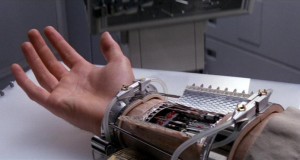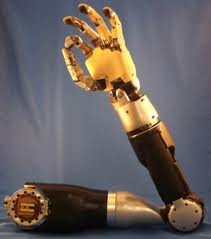
What’s scarier than robot soldiers and stealth drones?
The Borg Queen, grey goo, and spiders, for starters, but those are subjects for another time. I’m talking about viruses that can or will be able to infect militaristic AI.
Sometimes, viruses become the weapon of the good–in Independence Day, a bunch of computer geniuses lead by the Fly…er, Jeff Goldblum, develop a computer virus that allows the humans to defeat the big bad aliens.
But often in sci-fi, the enemy wields computer viruses. More often still, the robotic enemy. In addition to helping Baltar configure the Command Navigation Program to contain a backdoor that allows the cylons to render colonial vipers useless at the flip of a switch, the cylons also manage to infect the Battlestar’s computers. Even after the humans try to erase it, the virus replicates and compromises myriad systems on the ship, notifies the cylons of the weaknesses, and leaves the fleet open to attack.
Artificial intelligence is becoming an integral part of military operations, and it makes sense that computer viruses will become a focus of modern cyber warfare.
Last fall, unmanned U.S. drones were infected by a computer virus that contained software that recorded and transmitted typed instructions from the drone operator. Drones’ computer systems are closed, or offline, to prevent this type of attack. It’s likely the virus was installed or transferred from an external drive, but no one is completely sure. Similarly, it’s unclear where this virus came from or who may have masterminded it.
Last year, the Stuxnet virus set back Iran’s nuclear program by attacking its uranium enrichment facilities. Even though Israel never officially took credit for the virus, the commonly-held opinion is that Israeli engineers, likely with the help of U.S. engineers, built a perfect replica of Iran’s nuclear plant which they then used to develop the virus.
Iran’s nuclear facilities are also closed, and experts theorize that the virus traveled on a removable drive. Some think that the personal computers of plant personnel were infected first, and then those users unwittingly transferred the virus to the control system.
Back in 2009, the Conficker worm attacked Microsoft operating systems on approximately 10 million home, business, and government computers, including many in the Pentagon, in hundreds of countries (meanwhile, Mac users laughed and patted themselves on the back).
Viruses such as Conficker and the ubiquitous trojan horse worms marshal infected computers into a botnet, which then controls them. An evil, god-like supercomputer controlling all of the attacked systems sounds, at least to me, even more terrifying than a human supervillain.
Clearly, both good and evil geniuses will continue developing computer viruses that attack personal, business, and military systems. What I wonder is what happens if/when humans and machines hybridize. Could the humanoid of the future be susceptible to computer viruses just as we’re currently susceptible to disease?
Later in Battlestar Galactica, a virus that spreads both through the air and through the network causes the deaths of humanoid cylons, centurions, and even ships. One of the eeriest shots in the whole show depicts a convoy of cylon raiders drifting listlessly around an infected cylon basestar. The cylons pay for their hybridized status by being susceptible to both human and computerized virus transmissions.

In 2010, a scientist from the University of Reading in England implanted a tiny computer chip, much like the ones we use to identify animals, into his hand. The chip allowed him access into his secured building, and to his phone, among other things. He infected the chip with a virus that scrambled these links (but did not cause him any actual physical harm), and transferred the virus to a computer.
Theoretically, this means that viruses could spread from humans to machines, or vice versa. While most mechanical implants are currently self-contained, he believes that implants will become more like computers with networks, which means that someone’s pacemaker or cochlear implant could become infected and malfunction. There’s also the potential that at some point, someone with an infected device could infect someone else.
On the bright side, a future of computer viruses would provide welcome relief for needle-phobes. Imagine going to the doctor and instead of getting immunized or vaccinated, you plug in and download a new version of Norton or McAfee tailored to your exact physiology and needs. Those adds that pop up warning you that your system is susceptible to attack and urging you to renew your anti-virus subscription don’t seem quite as melodramatic or annoying as they did before.
 Ever thought about what superpower you’d have if you could choose one?
Ever thought about what superpower you’d have if you could choose one?














